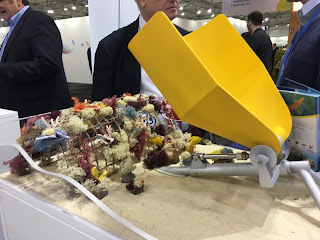Tech to Save the World
At the UK pavilion, they are demonstrating a couple different amazing environmental technologies. They have panels called Pavegen that absorb kinetic energy as you walk on them, and convert that energy into electricity. As the man at the pavilion explained to me, every single step we take is wasted energy. By capturing the energy in our steps, we are taking advantage of a a large untapped energy source: ourselves.
There is also a different form of hydropower on display made by CCell and BioRock This device uses the motion of waves to produce electricity. The electricity that is produced attracts calcium to a grid of wires, forming a basis for coral to eventually grow and thrive. This calicum forms limestone around the wires, which is when they seed the grid with live coral. The electrical current running through the grid helps the coral attract the calcium they need to grow, letting them put more energy into growth. By spending more energy on growing, they are able to grow at a rate that is 3-5x faster than normal (in extreme cases, up to 8x). This coral is not only wonderful for the environment around it, it also works as a natural sea wall. Instead of putting concrete and other unnatural objects in our waters that will get battered by the waves until they fall apart, we can take advantage of coral's natural ability to survive in the waves. Coral is dying from ocean pollution, ocean warming, and acidification. This device will not only create energy and provide security for countries, it will provide a physical habitat for coral.h
There are many tech companies doing amazing work for the environment, including Telephonic X and Microsoft. Telephonic X is utilizing the data that phones have been collecting for years to find where people are commuting, and how much CO2 they are emitting. This data will help governments for cities and countries make decisions and realize what actions need to take place. Microsoft is on the forefront of companies making decisions and taking action to reduce their own energy use and emissions, and help those around them to do the same. They have sensors that they attach all over cities that monitor energy efficiency. These allow them to identify how to make their buildings more energy efficient and reduce the cost of energy.
Virtual reality is all over at the conference, and is being used to tell stories. People can put on the headsets, and are transported to a place far far away to hear stories. The most powerful stories I’ve heard have been about the relocation of the people on islands. As sea level rises, small islands in the Asian Pacific are being swallowed up by water. Rising seas are flooding houses, crops, religious sites, burial grounds, and the land these people have been connected to, as well as their ancestors. These villages are being forced by climate change to leave their homes behind for higher ground. This isn't relocation, it is forced migration. The people on these lands produce significantly fewer emissions than are produced in the States or Europe or Asia, yet they are the ones paying the price for our pollution. At the Fiji pavilion, you can hear children tell their story of survival from the threat of climate change, and their story of hope.
Cora H.
There is also a different form of hydropower on display made by CCell and BioRock This device uses the motion of waves to produce electricity. The electricity that is produced attracts calcium to a grid of wires, forming a basis for coral to eventually grow and thrive. This calicum forms limestone around the wires, which is when they seed the grid with live coral. The electrical current running through the grid helps the coral attract the calcium they need to grow, letting them put more energy into growth. By spending more energy on growing, they are able to grow at a rate that is 3-5x faster than normal (in extreme cases, up to 8x). This coral is not only wonderful for the environment around it, it also works as a natural sea wall. Instead of putting concrete and other unnatural objects in our waters that will get battered by the waves until they fall apart, we can take advantage of coral's natural ability to survive in the waves. Coral is dying from ocean pollution, ocean warming, and acidification. This device will not only create energy and provide security for countries, it will provide a physical habitat for coral.h
 |
| CCell and Biorock System |
Virtual reality is all over at the conference, and is being used to tell stories. People can put on the headsets, and are transported to a place far far away to hear stories. The most powerful stories I’ve heard have been about the relocation of the people on islands. As sea level rises, small islands in the Asian Pacific are being swallowed up by water. Rising seas are flooding houses, crops, religious sites, burial grounds, and the land these people have been connected to, as well as their ancestors. These villages are being forced by climate change to leave their homes behind for higher ground. This isn't relocation, it is forced migration. The people on these lands produce significantly fewer emissions than are produced in the States or Europe or Asia, yet they are the ones paying the price for our pollution. At the Fiji pavilion, you can hear children tell their story of survival from the threat of climate change, and their story of hope.
Cora H.


Comments
Post a Comment
Thanks for the comment. We'll get it posted ASAP. Remember that we are in time zone UTC +1, seven hours ahead of Minnesota.